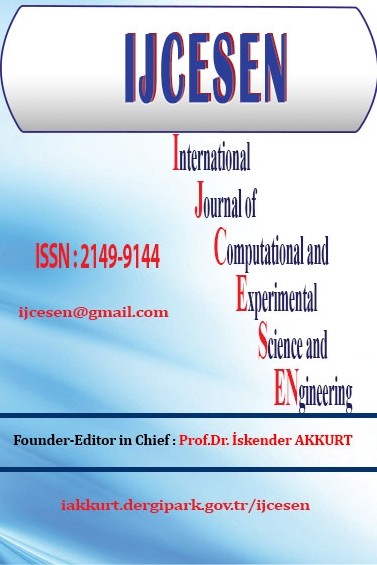e-Migraine: Development of a comprehensive tool to estimate Migraine Comorbidity Index Score
e-Migraine: Development of a comprehensive tool to estimate Migraine Comorbidity Index Score
e-Migraine, web-tool, Migraine Comorbidity Index,
___
- Referans1. Yeh WZ, Blizzard L, Taylor BV. “What is the actual prevalence of migraine?” Brain and Behaviour 8(6),1-6(2018).
- Referans2. Schera AI, Bigalb ME, Lipton RB. “Comorbidity of migraine” Curr Opin Neurol 18(3),305-310(2005).
- Referans3. Wang SJ, Chen PK, Fuh JL. “Comorbidities of migraine” Front Neurol 1(16),1-9(2010).
- Referans4. Barnett K, Mercer SW, Norbury M, Watt G, Wyke S, Guthrie B. “Epidemiology of multimorbidity and implications for health care, research, and medical education: a cross-sectional study”Lancet 380,37-43 (2012).
- Referans5. Valderas JM, Starfield B, Sibbald B, Salisbury C, Roland M. “Defining Comorbidity: Implications for Understanding Health and Health Services”The Annals of Family Medicine 7(4),357–363(2009).
- Referans6. Feinstein AR. “The pre-therapeutic classification of co-morbidity in chronic disease” J Chronic Dis 23(7),455-468(1970).
- Referans7. Groot V, Beckerman H, Lankhorst GJ, Bouter LM. “How to Measure Comorbidity: A Critical Review of Avaliable Methods” J Clin Epidemiol 56(3),221-229(2003).
- Referans8. Sarfati D. “Review of methods used to measure comorbidity in cancer populations: No gold standard exists” J Clin Epidemiol 65,924-33(2012).
- Referans9. Schneeweiss S, Maclure M. “Use of comorbidity scores for control of confounding in studies using administrative databases” International Journal of Epidemiology 29(5),891-898(2000).
- Referans10. Klabunde CN, Legler JML, Warren JL, Baldwin LM, Schrag D. “A refined comorbidity measurement algorithm for claims-based studies of breast, prostate, colorectal and lung cancer patients” Ann Epidemiol 17(8),584-90(2007).
- Referans11. Klabunde CN, Potosky AL, Legler JML, Warren JL. “Development of a comorbidity index using physician claims data” Journal of Clinical Epidemiology 53(12),1258-67(2000).
- Referans12. Hall SF. “A user’s guide to selecting a comorbidity index for clinical research” Journal of Clinical Epidemiology 59(8),849-55(2006).
- Referans13. Bateman BT, Mhyre JM, Hernandez-Diaz S, Huybrechts KF, Fischer MA, Creanga AA et al. “Development of a comorbidity index for use in obstetric” Obstet Gynecol 122(5),957-965(2013).
- Referans14. Laith A, Dodds P, Hutchings HA, Russel IT, Watkins A, Williams JG. “Development and validation of a new disease severity index: the inflammatory Bowel Disease Index (IBDEX)” Frontline Gastroenterol 6(3),161- 168(2015).
- Referans15. Rozzini R, Sabatini T, Barbisoni P, Trabucchi M, De Groot V, Beckerman H et al. “How to measure comorbidity in elderly persons (multiple letters)” Journal of Clinical Epidemiology 57(3),321-322 (2004).
- Referans16. Charlson ME, Pompei P, Ales KL, Mackenzie CR. “A new method of classifying prognostic comorbidity in longitudinal studies: Development and validation” J Chron Dis 40(5),373-383(1987).
- Referans17. Extermann M. “Measuring comorbidity in older cancer patients” European Journal of Cancer 36(4),453–471(2000).
- Referans18. Grunau GL, Sheps S, Goldner EM, Ratner PA. “Specific comorbidity risk adjustment was a better predictor of 5-year acute myocardial infarction mortality than general methods” Journal of Clinical Epidemiology 59(3),274–280(2006).
- Referans19. Derici Yıldırım D, Taşdelen B, Uludüz D, Özge A, Yoloğlu S. “Impact of a new migraine-specific comorbidity index on prognosis: A methodology study” Neurol Sci Neurophysiol 35(4),183-188(2018).
- Referans20. Aguilera A, Muench F. “There is an App for That: Information Technology Applications for Cognitive Behavioral Practitioners” Behav Ther 35(4),65-73(2012).
- Referans21. Tasdelen B, Ozge A, Kaleagasi H, Erdogan S, Mengi T. “Determining of migraine prognosis using latent growth mixture models” Chinese Medical Journal 124(7),1044-1049(2011).
- Referans22. Goddman LA. “Exploratory latent structure analysis using both identifiable and unidentifiable models” Biometrika 61,215-231(1974).
- Referans23. Linzer DA, Lewis J. “poLCA: an R Package for Polytomous Variable Latent Class Analysis” Journal of Statistical Software 42(10),1-29(2011).
- Referans24. Hooshmand B, Polvikoski T, Kivipelto M, Tanskanen M, Myllykangas L, Makela M et al. “CAIDE Dementia Risk Score, Alzheimer and Cerebrovascular pathology: A population-based autopsy study” J Intern Med 283(6),597-603(2018).
- Yayın Aralığı: 4
- Başlangıç: 2015
- Yayıncı: Prof.Dr. İskender Akkurt
Analysis of TSP: Simulated Annealing and Genetic Algorithm Approaches
Ahmet Reha BOTSALI, Kemal ALAYKIRAN
Evolutionary Search Algorithm Based on Hypercube Optimization For High-Dimensional Functions
Erhuvwuvoke EBOJOH, Elohor Diamond AKPOBİ
Experimental Study on Fracture Conductivity in Hydraulic Fracturing
Xingyuan LİANG, Fujian ZHOU, Tianbo LİANG, Jiawei ZHU, Rui WANG
Determining the Best Maternity Hospital by Using a Fuzzy Decision Making Model
Billur ECER, Ahmet AKTAS, Mehmet KABAK, Metin DAĞDEVİREN
Development of Design for Enhancing Trust in Cloud’s SPI Stack
Ahmed BENTAJER, Mustapha HEDABOU, Faouzia ENNAAMA, Said ELFEZAZİ
Dependent Dummy Variable Models: An Application of Logit, Probit and Tobit Models on Survey Data
Öznur İŞÇİ GÜNERİ, Burcu DURMUŞ
Fuzzy Logic Approach for Warping Problem In 3D Printing
Abdullah Burak KEŞKEKÇİ, Ramazan ŞENOL, Hilmi Cenk BAYRAKCI
e-Migraine: Development of a comprehensive tool to estimate Migraine Comorbidity Index Score
Didem DERİCİ YILDIRIM, Bahar TAŞDELEN, Tufan MENGİ, Aynur ÖZGE, Hamit GENÇ
